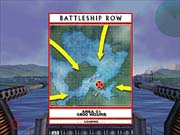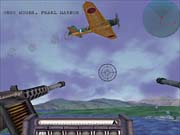In the 1980s, a string of gritty films and TV series like Platoon and Tour of Duty thrust the Vietnam War back into America's consciousness. For the past few years, the media spotlight has turned to World War II, producing films like Saving Private Ryan, The Thin Red Line, and Enemy at the Gates. It's probably no coincidence that WizardWorks released Pearl Harbor: Defend the Fleet just in time for the premiere of Touchstone Pictures' Pearl Harbor, the heavily promoted movie about Japan's unprovoked 1941 sneak attack on the US Pacific fleet in Hawaii. The game lets you play out an arcade version of the "date which will live in infamy," as President Roosevelt called the attack that left 21 ships damaged or sunk and more than 2,400 Americans dead. It's an old-school shoot-'em-up that would have been right at home in a 1980s arcade. Unfortunately, it would have been the dusty game in the corner that no one played.

Like in most arcade games, the gameplay in Pearl Harbor is simplicity itself. From a fixed deck gun aboard a ship in the harbor, you blast away at waves of Japanese attackers as you try to save the Pacific fleet. Each new stage brings more enemies, but you're armed more than well enough to handle them. You begin with a .50 caliber machine gun, and as the game progresses, more powerful weapons are added to your one-man arsenal. You'll get 20mm machine guns, 3-inch and 40mm antiaircraft guns, and "experimental" .50 caliber Gatling guns and rockets. You magically switch between these at will without changing gun positions.
Your .50 caliber and 20mm machine guns are automatically restocked after you exhaust their ammo, and the other guns are restocked from the occasional supply boat that miraculously manages to get its job done during a massive air raid. If you use up a supply of ammo, you'll lose points, though. Other than conserving ammo for the bigger, more powerful guns, your only other tactical consideration is leading your targets by trying to aim where the planes will be by the time the rounds reach them. You can zoom your view with the right mouse button, but it turns out to be a pretty superfluous feature since the planes all buzz by right near you. Other than that, there's really little to consider--just fire away.
Pearl Harbor, the game, features a brief history section about the attack on its namesake. Not surprisingly, though, the game takes liberties with history. You'll be fending off two versions each of the Aichi "Val" dive bomber, Mitsubishi "Zero" fighter, and Nakajima "Kate" torpedo bomber, as the Allies code-named them. While at least some variants of those planes attacked Pearl Harbor, you'll also try to shoot down the Ohka one-man suicide plane, which wasn't used until 1945. You'll fight midget subs too, though with deck guns instead of a destroyer's depth charges. Playing it fast and loose with history isn't really a bad thing for a game like this, since the speedy Ohka provides a tougher target than the fighters and bombers, and the relatively stealthy subs offer a little diversity.

The differences in the game between the Val, Zero, and Kate are mainly cosmetic, though. The planes are rendered decently enough--their appearance is crisp, and you can make out the markings on them easily. Their animations are also fast and fluid, but that's not surprising since they repeatedly fly the same tight little patterns around the seemingly miniature harbor. The game doesn't just play like a glorified shooting gallery, but it actually looks like one. You'll feel more like you're in a violent Walt Disney ride than aboard an imposing naval vessel. The undersized ships in the harbor add to that unfortunate impression, and their muddy low-resolution textures make them look more like gray blobs floating in the water than massive majestic battleships. The combat effects are a big letdown too, as planes just disappear in a sputtering little explosion when you hit them.
The sounds of combat are on par with graphics--in other words, they're subpar. The guns sound weighty enough, and occasional plinks from rounds hitting your ship create at least a tiny sense of personal danger. The planes should deafen you as they fly directly overhead, but they're pathetically quiet. Bland background music and a little intercom chatter do too little to immerse you in the action.
That's probably the biggest problem with Pearl Harbor: Defend the Fleet. What should be an adrenaline-pumping, action-packed experience grows outright dull in a hurry. It might be fun to blast away with your heavy guns for a few levels, but you'll feel too little tension and challenge to want to play long after that. The game is a cakewalk, and there are no difficulty levels to rectify that. The fact that the game bears a startling resemblance to WizardWorks' widely panned WWII shooting game BeachHead 2000 doesn't help its cause either. It's true that Pearl Harbor: Defend the Fleet makes no pretences to being anything other than a simplistic arcade action game, but it barely meets that low goal. Games like Defender and Missile Command offered more challenging and exciting gameplay along the same lines 20 years ago. Toss this one in the harbor.